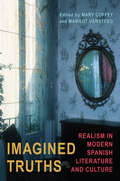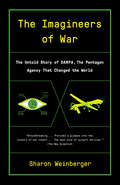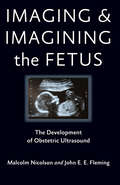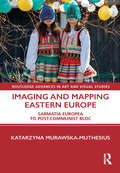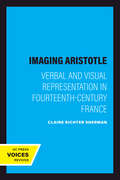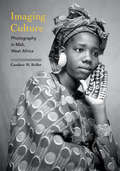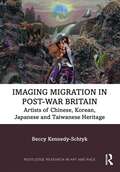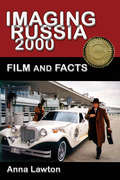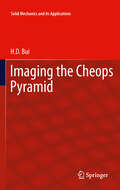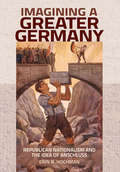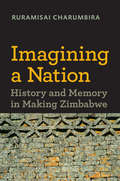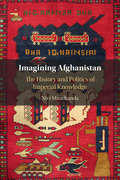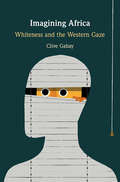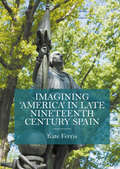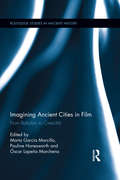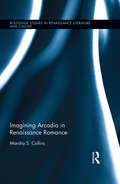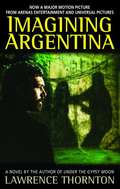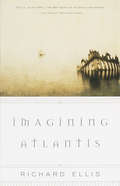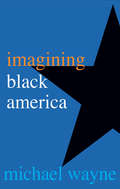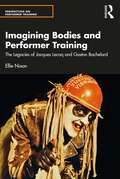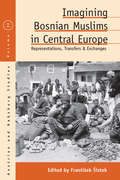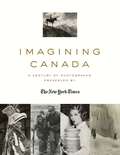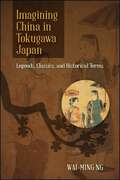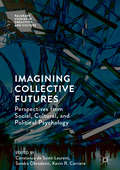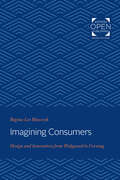- Table View
- List View
Imagined Truths: Realism in Modern Spanish Literature and Culture (Toronto Iberic)
by Mary L. Coffey Margot VersteegImagined Truths provides a twenty-first-century analysis of stylistic and philosophical manifestations of nineteenth- and twentieth-century Spanish literary realism. Bringing together the work of the foremost specialists in the field of contemporary Spanish letters, this collection offers new approaches to literary and cultural criticism and reveals how Spanish realism, far from being imitative of other European movements, engaged in complex and modern concepts of representation and mimesis. Imagined Truths acknowledges the critical importance of women writers and contemporary approaches to questions of gender. The essays address the impact of economics on our perceptions of reality and our constructions of everyday life, and they argue for the importance of emotions in the social construction of individual identity. Most importantly, they also acknowledge the post-imperial turn in literary studies. Addressing a broad range of authors, works, and topics, from the continued relevance of Cervantes’ Don Quijote to Spanish realism’s ability to move beyond narrative to inhabit the spaces of both theatre and film, Imagined Truths constitutes a series of meditations on new ways for understanding the unique place of realism in Spain’s cultural history. Offering insights for specialists in a wide range of disciplines, including literature, cultural studies, gender studies, history, and philosophy, this collection is equally important for readers becoming acquainted with realist narrative as a central component of Spanish literary history.
The Imagineers of War: The Untold Story of DARPA, the Pentagon Agency That Changed the World
by Sharon WeinbergerThe definitive history of the Defense Advanced Research Projects Agency, the Pentagon agency that has quietly shaped war and technology for nearly sixty years.Founded in 1958 in response to the launch of Sputnik, the agency’s original mission was to create “the unimagined weapons of the future.” Over the decades, DARPA has been responsible for countless inventions and technologies that extend well beyond military technology. Sharon Weinberger gives us a riveting account of DARPA’s successes and failures, its remarkable innovations, and its wild-eyed schemes. We see how the threat of nuclear Armageddon sparked investment in computer networking, leading to the Internet, as well as to a proposal to power a missile-destroying particle beam by draining the Great Lakes. We learn how DARPA was responsible during the Vietnam War for both Agent Orange and the development of the world’s first armed drones, and how after 9/11 the agency sparked a national controversy over surveillance with its data-mining research. And we see how DARPA’s success with self-driving cars was followed by disappointing contributions to the Afghanistan and Iraq wars.Weinberger has interviewed more than one hundred former Pentagon officials and scientists involved in DARPA’s projects—many of whom have never spoken publicly about their work with the agency—and pored over countless declassified records from archives around the country, documents obtained under the Freedom of Information Act, and exclusive materials provided by sources. The Imagineers of War is a compelling and groundbreaking history in which science, technology, and politics collide.
Imaging and Imagining the Fetus: The Development of Obstetric Ultrasound
by Malcolm Nicolson John E. FlemingHow engineers and clinicians developed the ultrasound diagnostic scanner and how its use in obstetrics became controversial.To its proponents, the ultrasound scanner is a safe, reliable, and indispensable aid to diagnosis. Its detractors, on the other hand, argue that its development and use are driven by the technological enthusiasms of doctors and engineers (and the commercial interests of manufacturers) and not by concern to improve the clinical care of women. In some U.S. states, an ultrasound scan is now required by legislation before a woman can obtain an abortion, adding a new dimension to an already controversial practice. Imaging and Imagining the Fetus engages both the development of a modern medical technology and the concerted critique of that technology.Malcolm Nicolson and John Fleming relate the technical and social history of ultrasound imaging—from early experiments in Glasgow in 1956 through wide deployment in the British hospital system by 1975 to its ubiquitous use in maternity clinics throughout the developed world by the end of the twentieth century. Obstetrician Ian Donald and engineer Tom Brown created ultrasound technology in Glasgow, where their prototypes were based on the industrial flaw detector, an instrument readily available to them in the shipbuilding city. As a physician, Donald supported the use of ultrasound for clinical purposes, and as a devout High Anglican he imbued the images with moral significance. He opposed abortion—decisions about which were increasingly guided by the ultrasound technology he pioneered—and he occasionally used ultrasound images to convince pregnant women not to abort the fetuses they could now see.Imaging and Imagining the Fetus explores why earlier innovators failed where Donald and Brown succeeded. It also shows how ultrasound developed into a "black box" technology whose users can fully appreciate the images they produce but do not, and have no need to, understand the technology, any more than do users of computers. These "images of the fetus may be produced by machines," the authors write, "but they live vividly in the human imagination."
Imaging and Mapping Eastern Europe: Sarmatia Europea to Post-Communist Bloc (Routledge Advances in Art and Visual Studies)
by Katarzyna Murawska-MuthesiusImaging and Mapping Eastern Europe puts images centre stage and argues for the agency of the visual in the construction of Europe’s east as a socio-political and cultural entity. This book probes into the discontinuous processes of mapping the eastern European space and imaging the eastern European body. Beginning from the Renaissance maps of Sarmatia Europea, it moves onto the images of women in ethnic dress on the pages of travellers’ reports from the Balkans, to cartoons of children bullied by dictators in the satirical press, to Cold War cartography, and it ends with photos of protesting crowds on contemporary dust jackets. Studying the eastern European ‘iconosphere’ leads to the engagement with issues central for image studies and visual culture: word and image relationship, overlaps between the codes of othering and self-fashioning, as well as interaction between the diverse modes of production specific to cartography, travel illustrations, caricature, and book cover design. This book will be of interest to scholars in art history, visual culture, and central Asian, Russian and Eastern European studies.
Imaging Aristotle: Verbal and Visual Representation in Fourteenth-Century France
by Claire Richter ShermanThis title is part of UC Press's Voices Revived program, which commemorates University of California Press’s mission to seek out and cultivate the brightest minds and give them voice, reach, and impact. Drawing on a backlist dating to 1893, Voices Revived makes high-quality, peer-reviewed scholarship accessible once again using print-on-demand technology. This title was originally published in 1995.This title is part of UC Press's Voices Revived program, which commemorates University of California Press’s mission to seek out and cultivate the brightest minds and give them voice, reach, and impact. Drawing on a backlist dating to 1893, Voices Revived</DIV
Imaging Culture: Photography in Mali, West Africa (African Expressive Cultures)
by Candace M. KellerImaging Culture is a sociohistorical study of the meaning, function, and aesthetic significance of photography in Mali, West Africa, from the 1930s to the present. Spanning the dynamic periods of colonialism, national independence, socialism, and democracy, its analysis focuses on the studio and documentary work of professional urban photographers, particularly in the capital city of Bamako and in smaller cities such as Mopti and Ségu. Featuring the work of more than twenty-five photographers, it concentrates on those who have been particularly influential for the local development and practice of the medium as well as its international popularization and active participation in the contemporary art market. Imaging Culture looks at how local aesthetic ideas are visually communicated in the photographers' art and argues that though these aesthetic arrangements have specific relevance for local consumers, they transcend geographical and cultural boundaries to have value for contemporary global audiences as well. Imaging Culture is an important and visually interesting book which will become a standard source for those who study African photography and its global impact.
Imaging Migration in Post-War Britain: Artists of Chinese, Korean, Japanese and Taiwanese Heritage (Routledge Research in Art and Race)
by Beccy Kennedy-SchtykThis book examines the artistic practices of a range of British-based artists of East Asian (Chinese, Japanese, Korean and Taiwanese) heritage to consider the social, political and cultural effects of migration or diaspora on their creative production.Beccy Kennedy-Schtyk demonstrates three themes: the multiplicity and expansive contemporaneity of these artists’ visual oeuvres; the physical impact or interpretation of migratory circumstances on their artistic practices; and the necessity to continue to evolve ways of thinking about migration, race and border crossings in the current political climate of the 21st century.The book will be of interest to scholars studying art history, Asian studies, British studies, migration and diaspora studies, and cultural studies.
Imaging Russia 2000: Film and Facts
by Anna Lawton“[A] sparkling and original work . . . I can think of no better guide to the heart of post-Soviet urban Russia than this entertaining and refreshing book.” —Richard Stites, Professor of History, Georgetown UniversityThis book incorporates into an organic whole the realities of the 1990s in Russia, focusing on film production, the films themselves, and the socio-political-cultural context. It aims to provide a picture of Russia (with Moscow in the foreground) as the big stage on which the drama unfolded. The author discusses some eighty films made between 1990 and 2000. Many reflect the reality of the present day, either in dramatic or grotesque form. Others reassess the past, placing different spins on various epochs and figures according to the director’s ideological orientation. Still others offer escapism into imaginary worlds. The films selected may vary in technical quality and depth of thought; they may be mainstream pictures, or art films. But taken together, they provide an eloquent portrait of Russia, entering the new millennium still in search of its true identity.A Choice Outstanding Academic Title“Anna Lawton deftly tells two stories—one about the evolution of Russian film since the collapse of the Soviet Union in 1991, and the other about Russian life during that same period. She managed to capture a vivid portrait of Moscow of the 1990s, and to remind us that the Soviet past remains omnipresent in the new Russia . . . a must read for anyone who cares about Russia, or about film.” —Blair Ruble, Director, The Kennan Institute of the Woodrow Wilson Center
Imaging the Cheops Pyramid
by H. D. BuiIn this book Egyptian Archeology and Mathematics meet. The author is an expert in theories and applications in Solid Mechanics and Inverse Problems, a former professor at Ecole Polytechnique and now works with Electricité de France on maintenance operations on nuclear power plants. In the Autumn of 1986, after the end of the operation on the King's chamber conducted under the Technological and Scientific Sponsorship of EDF, to locate a cavity, he was called to solve a mathematical inverse problem, to find the unknown tomb of the King and the density structure of the whole pyramid based on measurements of microgravity made inside and outside of the pyramid. This book recounts the various search operations on the pyramid of Cheops made at the request of the Egyptian and French authorities in 1986-1987. After the premature end of the Cheops operation in the Autumn of 1986, following the fiasco of unsuccessful drillings in the area suspected by both architects G. Dormion and J.P. Goidin and microgravity auscultation, EDF and CPGF (a geophysical company) teams continued their researches with measurements already made, trying this time an inversion of the Newton gravity equation for the entire pyramid and using another theoretical team led by the author. The inverse problem solution confirmed the results of auscultations, but found no cavity. However, the image of the average density at the surface of the entire pyramid forms a sort of square "spiral" probably related to the construction method. In 2000, Jean-Pierre Houdin considered the author's results of 1988 as a confirmation of his theory of the internal ramp tunnel. Since then the author has done additional research and found that classical theories of the construction based on degrees and the particular mode of stones filling can also report the same densitogram. The book is richly illustrated with color figures. It is dotted with information concerning Physics, Mechanics and the History of Egyptian Antiquities. The book ends with the greatest mystery of the pyramid about the unknown tomb of the King and a dream to see the tomb at an unexpected place.
Imagining a Greater Germany: Republican Nationalism and the Idea of Anschluss
by Erin R. HochmanIn Imagining a Greater Germany, Erin R. Hochman offers a fresh approach to the questions of state- and nation-building in interwar Central Europe. Ever since Hitler annexed his native Austria to Germany in 1938, the term "Anschluss" has been linked to Nazi expansionism. The legacy of Nazism has cast a long shadow not only over the idea of the union of German-speaking lands but also over German nationalism in general. Due to the horrors unleashed by the Third Reich, German nationalism has seemed virulently exclusionary, and Anschluss inherently antidemocratic.However, as Hochman makes clear, nationalism and the desire to redraw Germany's boundaries were not solely the prerogatives of the political right. Focusing on the supporters of the embattled Weimar and First Austrian Republics, she argues that support for an Anschluss and belief in the großdeutsch idea (the historical notion that Germany should include Austria) were central to republicans’ persistent attempts to legitimize democracy. With appeals to a großdeutsch tradition, republicans fiercely contested their opponents’ claims that democracy and Germany, socialism and nationalism, Jew and German, were mutually exclusive categories. They aimed at nothing less than creating their own form of nationalism, one that stood in direct opposition to the destructive visions of the political right. By challenging the oft-cited distinction between “good” civic and “bad” ethnic nationalisms and drawing attention to the energetic efforts of republicans to create a cross-border partnership to defend democracy, Hochman emphasizes that the triumph of Nazi ideas about nationalism and politics was far from inevitable.
Imagining a Nation: History and Memory in Making Zimbabwe (Reconsiderations in Southern African History)
by Ruramisai CharumbiraIn Imagining a Nation, Ruramisai Charumbira analyzes competing narratives of the founding of Rhodesia/Zimbabwe constructed by political and cultural nationalists both black and white since occupation in 1890. The book uses a wide array of sources--including archives, oral histories, and a national monument--to explore the birth of the racialized national memories and parallel identities that were in vigorous contention as memory sought to present itself as history. In contrast with current global politics plagued by divisions of outsider and insider, patriot and traitor, Charumbira invites the reader into the liminal spaces of the region's history and questions the centrality of the nation-state in understanding African or postcolonial history today. Using an interdisciplinary methodology, Charumbira offers a series of case studies, bringing in characters from far-flung places to show that history and memory in and of one small place can have a far-reaching impact in the wider world. The questions raised by these stories go beyond the history of colonized or colonizer in one former colony to illuminate contemporary vexations about what it means to be a citizen, patriot, or member of a nation in an ever-globalizing world. Rather than a history of how the rulers of Rhodesia or Zimbabwe marshaled state power to force citizens to accept a single definition of national memory and identity, Imagining a Nation shows how ordinary people invested in the soft power of individual, social, and collective memories to create and perpetuate exclusionary national myths.Reconsiderations in Southern African History
Imagining Afghanistan: The History and Politics of Imperial Knowledge
by Nivi ManchandaOver time and across different genres, Afghanistan has been presented to the world as potential ally, dangerous enemy, gendered space, and mysterious locale. These powerful, if competing, visions seek to make sense of Afghanistan and to render it legible. In this innovative examination, Nivi Manchanda uncovers and critically explores Anglophone practices of knowledge cultivation and representational strategies, and argues that Afghanistan occupies a distinctive place in the imperial imagination: over-determined and under-theorised, owing largely to the particular history of imperial intervention in the region. Focusing on representations of gender, state and tribes, Manchanda re-historicises and de-mythologises the study of Afghanistan through a sustained critique of colonial forms of knowing and demonstrates how the development of pervasive tropes in Western conceptions of Afghanistan have enabled Western intervention, invasion and bombing in the region from the nineteenth century to the present.
Imagining Africa: Whiteness and the Western Gaze
by Clive GabayThere has been a long history of idealism concerning the potential of economic and political developments in Africa, the latest iteration of which emerged around the time of the 2007–8 global financial crisis. Here, Clive Gabay takes a historical approach to questions concerning change and international order as these apply to Africa in Western imaginaries. Challenging traditional postcolonial accounts that see the West imagine itself as superior to Africa, he argues that the centrality of racial anxieties concerning white supremacy make Africa appear, at moments of Western crisis, as the saviour of Western ideals, specifically democracy, bureaucracy, and neoclassical economic order. Uncommonly, this book turns its lens as much inwards as outwards, interrogating how changing attitudes to Africa over the course of the twentieth and early twenty-first centuries correspond to shifting anxieties concerning whiteness, and the growing hope that Africa will be the place where the historical genius of whiteness might be saved and perpetuated.
Imagining 'America' in late Nineteenth Century Spain
by Kate FerrisThis book examinesthe processes of production, circulation and reception of images of America inlate nineteenth century Spain. When late nineteenth century Spaniards looked atthe United States, they, like Tocqueville, 'saw more than America'. What did they see? Between the 'glorious'liberal revolution of 1868 and the run-up to the 1898 war with the US thatwould end Spain's New World empire, Spanish liberal and democratic reformersimagined the USA as a place where they could preview the 'modern way of life',as a political and social model (or anti-model) to emulate, appropriate or reject,and above all as a 100 year experiment of republicanism, democracy and libertyin practice. Through their writings and discussions of the USA, these Spaniardsdebated and constructed their own modernity and imagined the place of theirnation in the modern world.
Imagining Ancient Cities in Film: From Babylon to Cinecittà (Routledge Studies in Ancient History)
by Marta Garcia Morcillo Pauline Hanesworth Óscar Lapeña MarchenaIn film imagery, urban spaces show up not only as spatial settings of a story, but also as projected ideas and forms that aim to recreate and capture the spirit of cultures, societies and epochs. Some cinematic cities have even managed to transcend fiction to become part of modern collective memory. Can we imagine a futuristic city not inspired at least remotely by Fritz Lang’s Metropolis? In the same way, ancient Babylon, Troy and Rome can hardly be shaped in popular imagination without conscious or subconscious references to the striking visions of Griffiths’ Intolerance, Petersen’s Troy and Scott’s Gladiator, to mention only a few influential examples. Imagining Ancient Cities in Film explores for the first time in scholarship film representations of cities of the Ancient World from early cinema to the 21st century. The volume analyzes the different choices made by filmmakers, art designers and screen writers to recreate ancient urban spaces as more or less convincing settings of mythical and historical events. In looking behind and beyond intended archaeological accuracy, symbolic fantasy, primitivism, exoticism and Hollywood-esque monumentality, this volume pays particular attention to the depiction of cities as faces of ancient civilizations, but also as containers of moral ideas and cultural fashions deeply rooted in the contemporary zeitgeist and in continuously revisited traditions.
Imagining Arcadia in Renaissance Romance (Routledge Studies in Renaissance Literature and Culture)
by Marsha S. CollinsFrom Theocritus’ Idylls to James Cameron’s Avatar, Arcadia remains an enduring presence in world culture and a persistent source of creative inspiration. Why does Arcadia still exercise such a powerful pull on the imagination? This book responds by arguing that in sixteenth-century Europe, a dramatic shift took place in imagining Arcadia. The traditional visions of Arcadia collided and fused with romance, the new experimental form of prose fiction, producing a hybrid, dynamic world of change and transformation. Emphasizing matters of fictional function and world-making over generic classification, Imagining Arcadia in Renaissance Romance analyzes the role of romance as a catalyst in remaking Arcadia in five, canonical sixteenth-century texts: Sannazaro’s Arcadia; Montemayor’s La Diana; Cervantes’ La Galatea; Sidney’s Arcadia; and Lope de Vega’s Arcadia. Collins’ analyses of the re-imagined Arcadia in these works elucidate the interplay between timely incursions into the fictional world and the timelessness of art, highlighting issues of freedom, identity formation, subjectivity and self-fashioning, the intersection of public and private activity, and the fascination with mortality. This book addresses the under-representation of Spanish literature in Early Modern literary histories, especially regarding the rich Spanish contribution to the pastoral and to idealizing fiction in the West. Companion chapters on Cervantes and Sidney add to the growing field of Anglo-Spanish comparative literary studies, while the book’s comparative and transnational approach extends discussion of the pastoral beyond the boundaries of national literary traditions. This book’s innovative approach to these fictional worlds sheds new light on Arcadia’s enduring presence in the collective imagination today.
Imagining Argentina
by Lawrence ThorntonImagining Argentina is set in the dark days of the late 1970's, when thousands of Argentineans disappeared without a trace into prison cells and torture chambers. When Carlos Rueda's wife is suddenly taken from him, he discovers a magical gift: In waking dreams, he had clear visions of the fates of "the disappeared. " But he cannot "imagine" what has happened to his own wife. Driven to near madness, his mind cannot be taken away: imagination, stories, and the mystical secrets of the human spirit. Note: Inconsistent use of accents in original text.
Imagining Atlantis
by Richard EllisEver since Plato created the legend of the lost island of Atlantis, it has maintained a uniquely strong grip on the human imagination. For two and a half millennia, the story of the city and its catastrophic downfall has inspired people--from Francis Bacon to Jules Verne to Jacques Cousteau--to speculate on the island's origins, nature, and location, and sometimes even to search for its physical remains. It has endured as a part of the mythology of many different cultures, yet there is no indisputable evidence, let alone proof, that Atlantis ever existed. What, then, accounts for its seemingly inexhaustible appeal?Richard Ellis plunges into this rich topic, investigating the roots of the legend and following its various manifestations into the present. He begins with the story's origins. Did it arise from a common prehistorical myth? Was it a historical remnant of a lost city of pre-Columbians or ancient Egyptians? Was Atlantis an extraterrestrial colony? Ellis sifts through the "scientific" evidence marshaled to "prove" these theories, and describes the mystical and spiritual significance that has accrued to them over the centuries. He goes on to explore the possibility that the fable of Atlantis was inspired by a conflation of the high culture of Minoan Crete with the destruction wrought on the Aegean world by the cataclysmic eruption, around 1500 b.c., of the volcanic island of Thera (or Santorini).A fascinating historical and archaeological detective story, Imagining Atlantis is a valuable addition to the literature on this essential aspect of our mythohistory.From the Hardcover edition.
Imagining Black America
by Michael WayneScientific research has now established that race should be understood as a social construct, not a true biological division of humanity. In Imagining Black America, Michael Wayne explores the construction and reconstruction of black America from the arrival of the first Africans in Jamestown in 1619 to Barack Obama's reelection. Races have to be imagined into existence and constantly reimagined as circumstances change, Wayne argues, and as a consequence the boundaries of black America have historically been contested terrain. He discusses the emergence in the nineteenth century-and the erosion, during the past two decades-of the notorious "one-drop rule." He shows how significant periods of social transformation-emancipation, the Great Migration, the rise of the urban ghetto, and the Civil Rights Movement-raised major questions for black Americans about the defining characteristics of their racial community. And he explores how factors such as class, age, and gender have influenced perceptions of what it means to be black. Wayne also considers how slavery and its legacy have defined freedom in the United States. Black Americans, he argues, because of their deep commitment to the promise of freedom and the ideals articulated by the Founding Fathers, became and remain quintessential Americans-the "incarnation of America," in the words of the civil rights leader A. Philip Randolph.
Imagining Bodies and Performer Training: The Legacies of Jacques Lecoq and Gaston Bachelard (Perspectives on Performer Training)
by Ellie NixonThis book is a practical and theoretical exploration of the embodied imagining processes of devised performance in which the human and more-than-human are co-implicated in the creative process.This study brings together the work of French theatre pedagogue Jacques Lecoq (1921–1999) and French philosopher of science and the imagination Gaston Bachelard (1884–1962) to explore the notion of the imagination as embodied, enactive and embedded in the devising process. An exploration of compelling correspondences with Bachelard, whose writings imbue Lecoq’s teaching ethos, offers new practical and theoretical perspectives on Lecoq’s ‘poetic body’ in contemporary devising practices. Interweaving first-hand accounts by the author and interviews with contemporary international creative practitioners who have graduated from or have been deeply influenced by Lecoq, Imagining Bodies in Performer Training interrogates how his teachings have been adapted, developed and extended in various cultural, political and historical settings, in Europe, Scandinavia, Asia, and North and South America.These new and rich insights reveal a teaching approach that resists fixity and instead unfolds, develops and adapts to the diverse cultural and political contexts of its practitioners, teachers and students.
Imagining Bosnian Muslims in Central Europe: Representations, Transfers and Exchanges (Austrian and Habsburg Studies #32)
by František ŠístekAs a Slavic-speaking religious and ethnic “Other” living just a stone’s throw from the symbolic heart of the continent, the Muslims of Bosnia and Herzegovina have long occupied a liminal space in the European imagination. To a significant degree, the wider representations and perceptions of this population can be traced to the reports of Central European—and especially Habsburg—diplomats, scholars, journalists, tourists, and other observers in the late nineteenth and early twentieth centuries. This volume assembles contributions from historians, anthropologists, political scientists, and literary scholars to examine the political, social, and discursive dimensions of Bosnian Muslims’ encounters with the West since the nineteenth century.
Imagining Canada: A Century of Photographs Preserved By The New York Times
by William MorassuttiSophisticated and well-curated, this photographic tour through Canada's history documents the nation's evolution over more than a century, as seen through the lens of photographers from The New York Times. The book compiles more than 100 iconic, momentous and inspiring images of Canada and includes ten commentary pieces from a range of important thinkers, historians and writers, including National Chief Shawn Atleo, MP Justin Trudeau, historians Charlotte Gray, Peter C. Newman and Tim Cook, and sports columnist Stephen Brunt. Through these pages and images, which represent a portal in time, a portrait of Canada emerges, not as seen by its own citizens, but as viewed through a distinctly American lens.The book includes photos arranged according to the following themes: • The Battlefield: Canada at War • Aboriginal People • The Changing Face of Canadian Society--Our Immigration Story • Landscape • The Political Arena • Industry • The War Machine: How the Homefront Supplied the Wars • Hockey • Icons (Stars, Sports Heroes, Political Figures, Royalty)
Imagining China in Tokugawa Japan: Legends, Classics, and Historical Terms
by Wai-ming NgWhile current scholarship on Tokugawa Japan (1603–1868) tends to see China as either a model or "the Other," Wai-ming Ng's pioneering and ambitious study offers a new perspective by suggesting that Chinese culture also functioned as a collection of "cultural building blocks" that were selectively introduced and then modified to fit into the Japanese tradition. Chinese terms and forms survived, but the substance and the spirit were made Japanese. This borrowing of Chinese terms and forms to express Japanese ideas and feelings could result in the same things having different meanings in China and Japan, and this process can be observed in the ways in which Tokugawa Japanese reinterpreted Chinese legends, Confucian classics, and historical terms. Ng breaks down the longstanding dichotomies between model and "the other," civilization and barbarism, as well as center and periphery that have been used to define Sino-Japanese cultural exchange. He argues that Japanese culture was by no means merely an extended version of Chinese culture, and Japan's uses and interpretations of Chinese elements were not simply deviations from the original teachings. By replacing a Sinocentric perspective with a cross-cultural one, Ng's study represents a step forward in the study of Tokugawa intellectual history.
Imagining Collective Futures: Perspectives From Social, Cultural And Political Psychology (Palgrave Studies in Creativity and Culture)
by Kevin R. Carriere Sandra Obradović Constance de Saint-LaurentIt is a commonly held assumption among cultural, social, and political psychologists that imagining the future of societies we live in has the potential to change how we think and act in the world. However little research has been devoted to whether this effect exists in collective imaginations, of social groups, communities and nations, for instance. This book explores the part that imagination and creativity play in the construction of collective futures, and the diversity of outlets in which these are presented, from fiction and cultural symbols to science and technology. The authors discuss this effect in social phenomena such as in intergroup conflict and social change, and focus on several cases studies to illustrate how the imagination of collective futures can guide social and political action. This book brings together theoretical and empirical contributions from cultural, social, and political psychology to offer insight into our constant (re)imagination of the societies in which we live.
Imagining Consumers: Design and Innovation from Wedgwood to Corning (Studies in Industry and Society #16)
by Regina Lee BlaszczykWinner of the Hagley Prize in Business History from The Hagley Museum and Library and the Business History ConferenceSelected by Choice Magazine as an Outstanding Academic TitleOriginally published in 1999. Imagining Consumers tells for the first time the story of American consumer society from the perspective of mass-market manufacturers and retailers. It relates the trials and tribulations of china and glassware producers in their contest for the hearts of the working- and middle-class women who made up more than eighty percent of those buying mass-manufactured goods by the 1920s. Based on extensive research in untapped corporate archives, Imagining Consumers supplies a fresh appraisal of the history of American business, culture, and consumerism. Case studies illuminate decision making in key firms—including the Homer Laughlin China Company, the Kohler Company, and Corning Glass Works—and consider the design and development of ubiquitous lines such as Fiesta tableware and Pyrex Ovenware.
